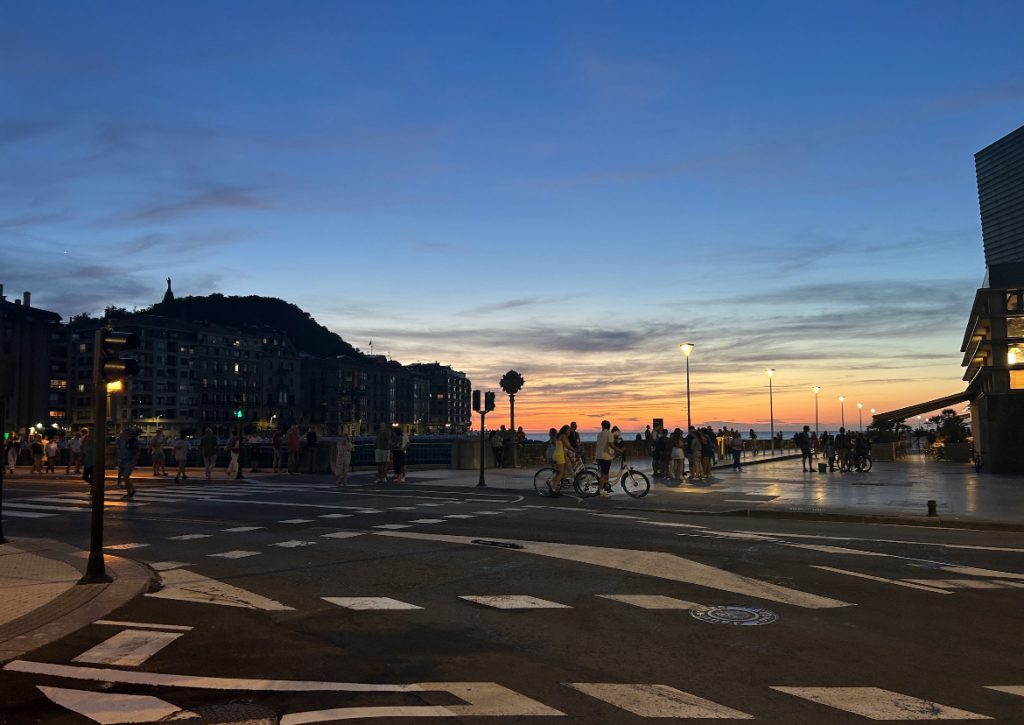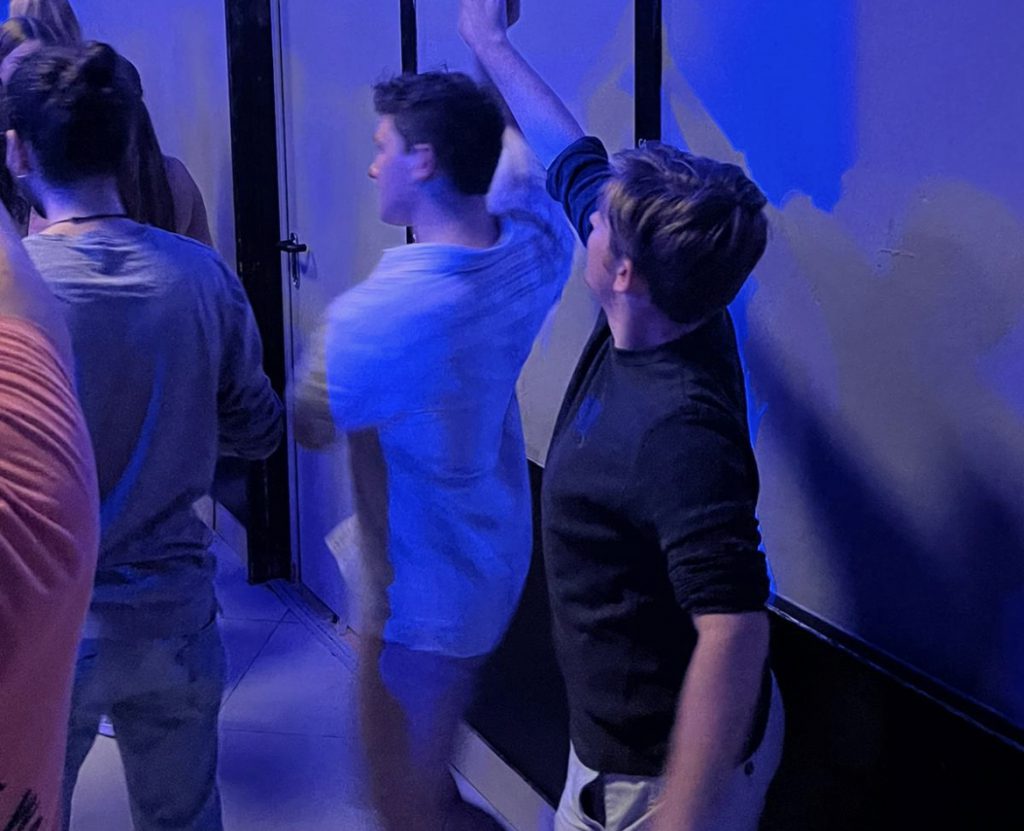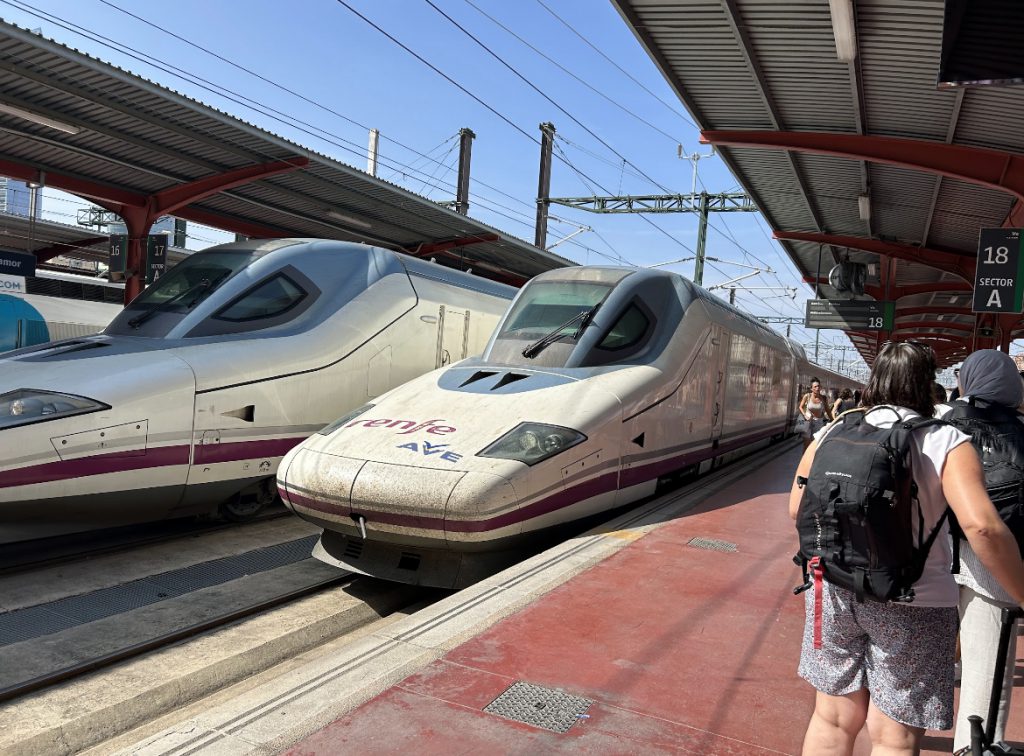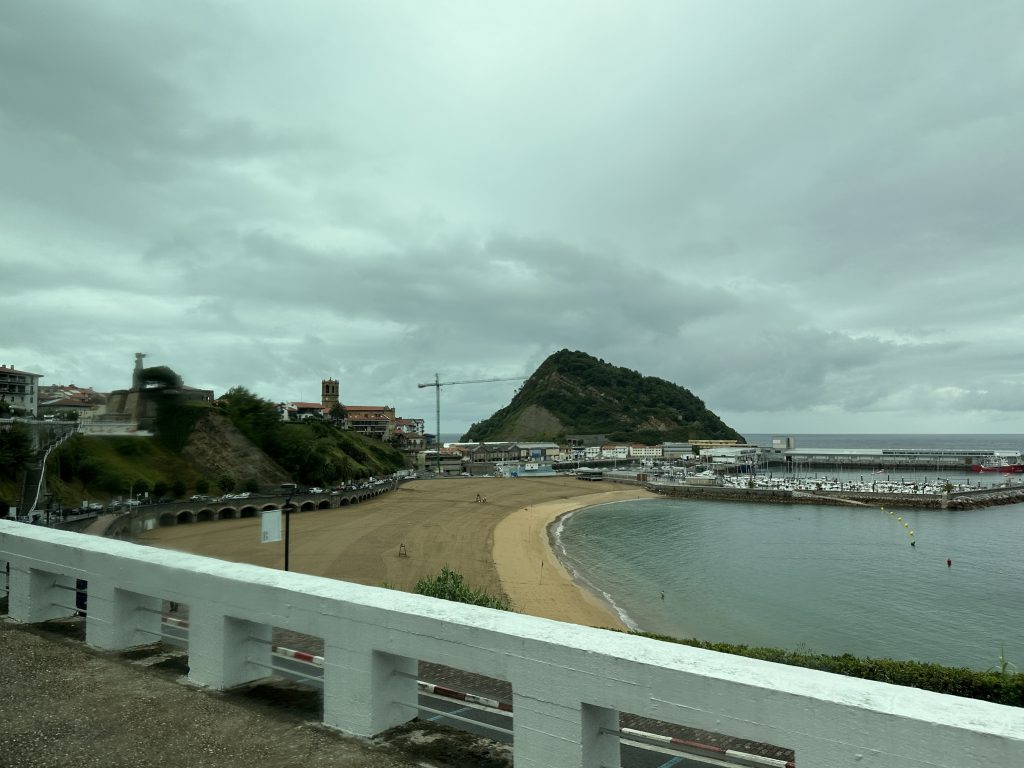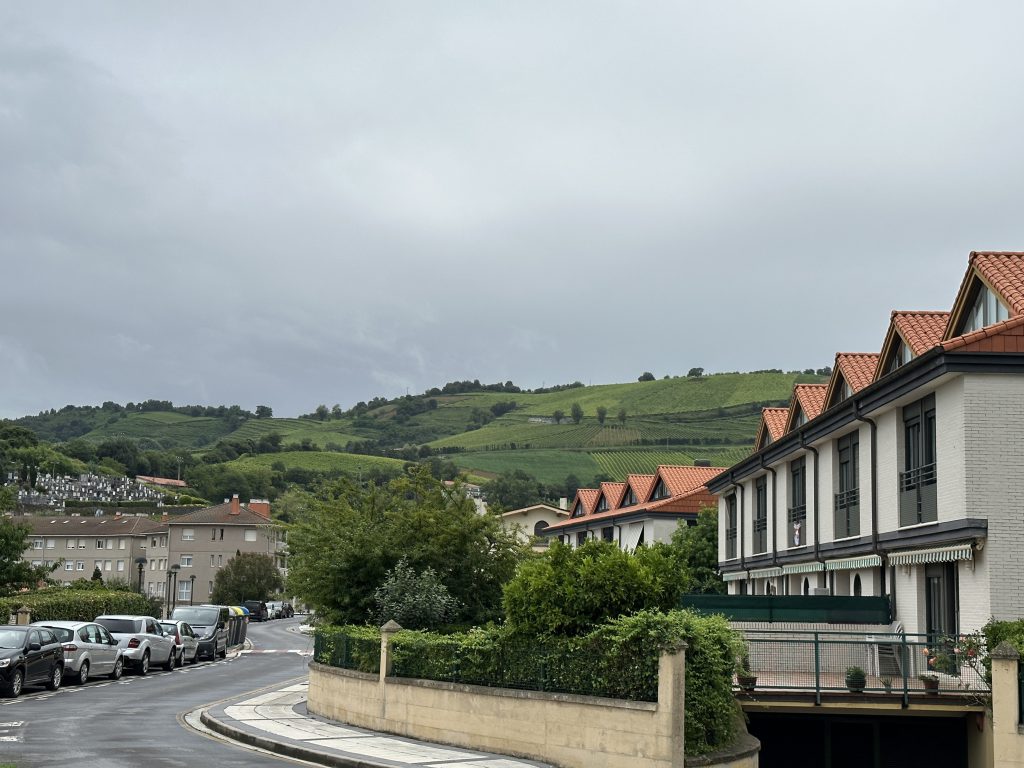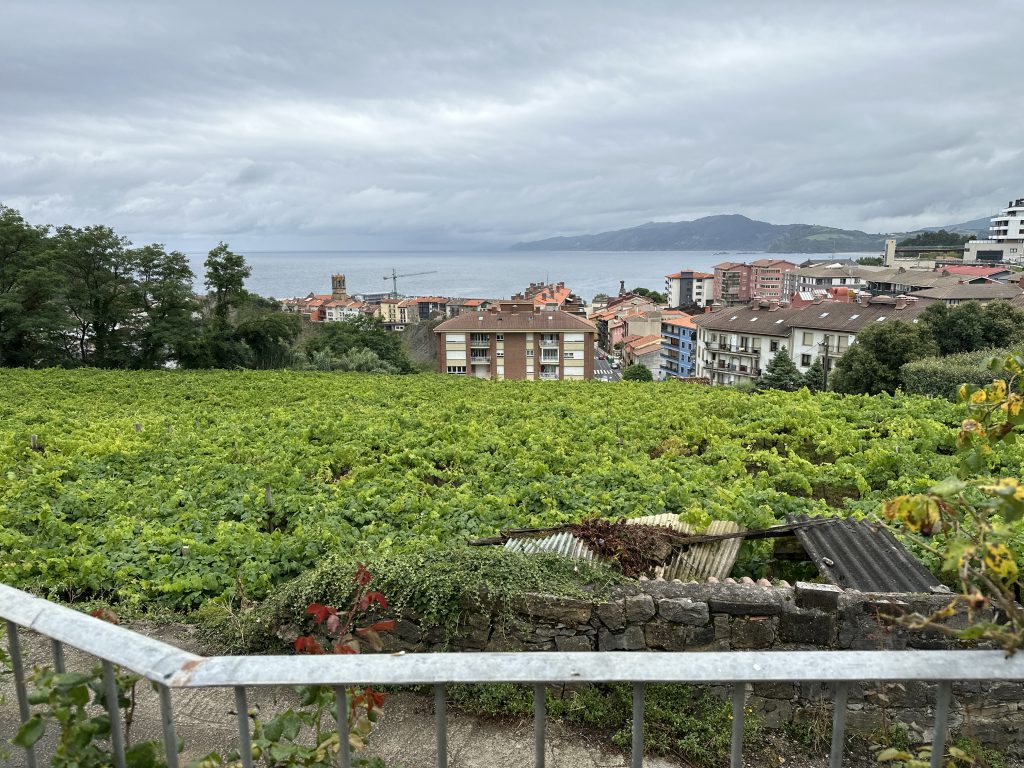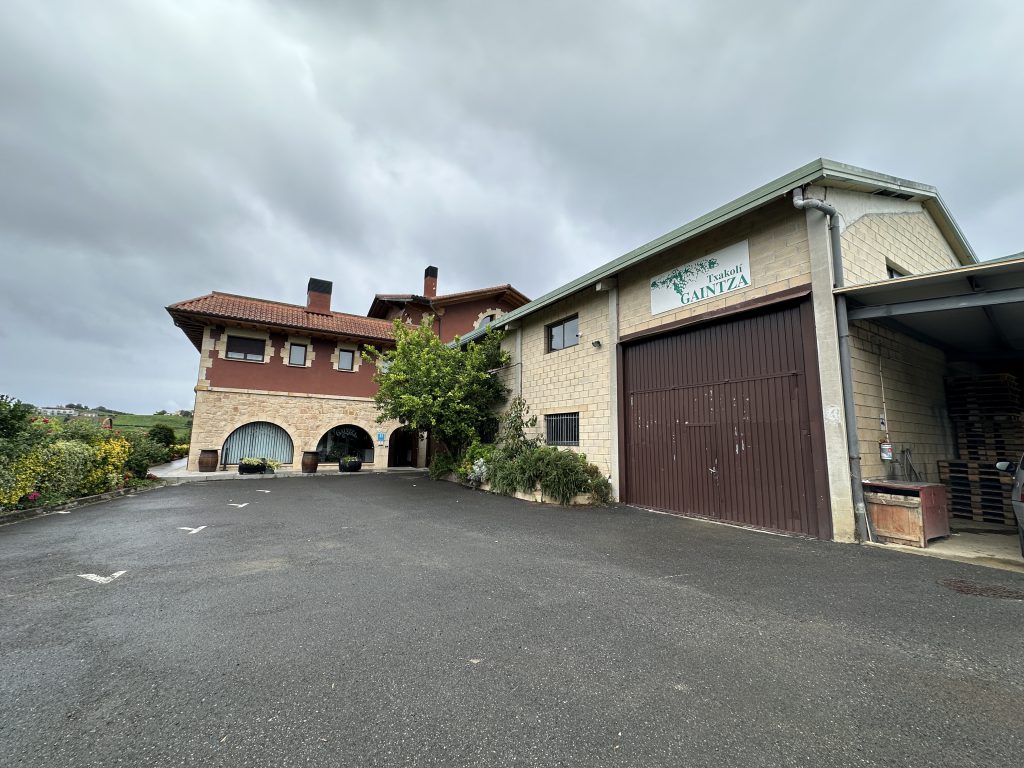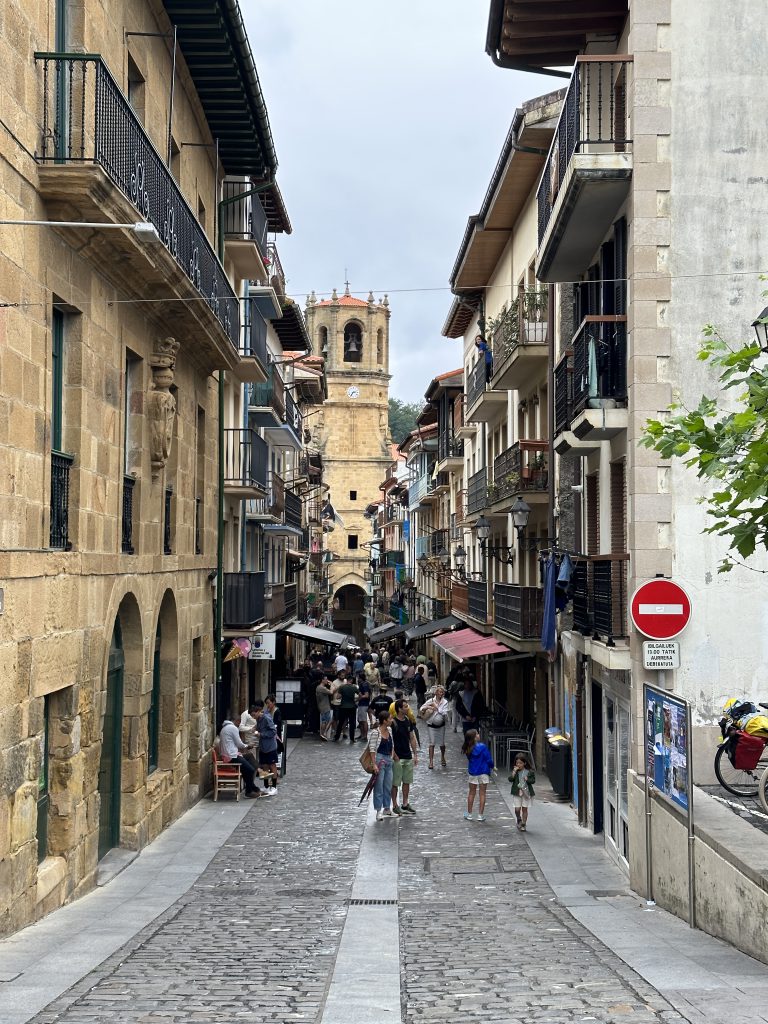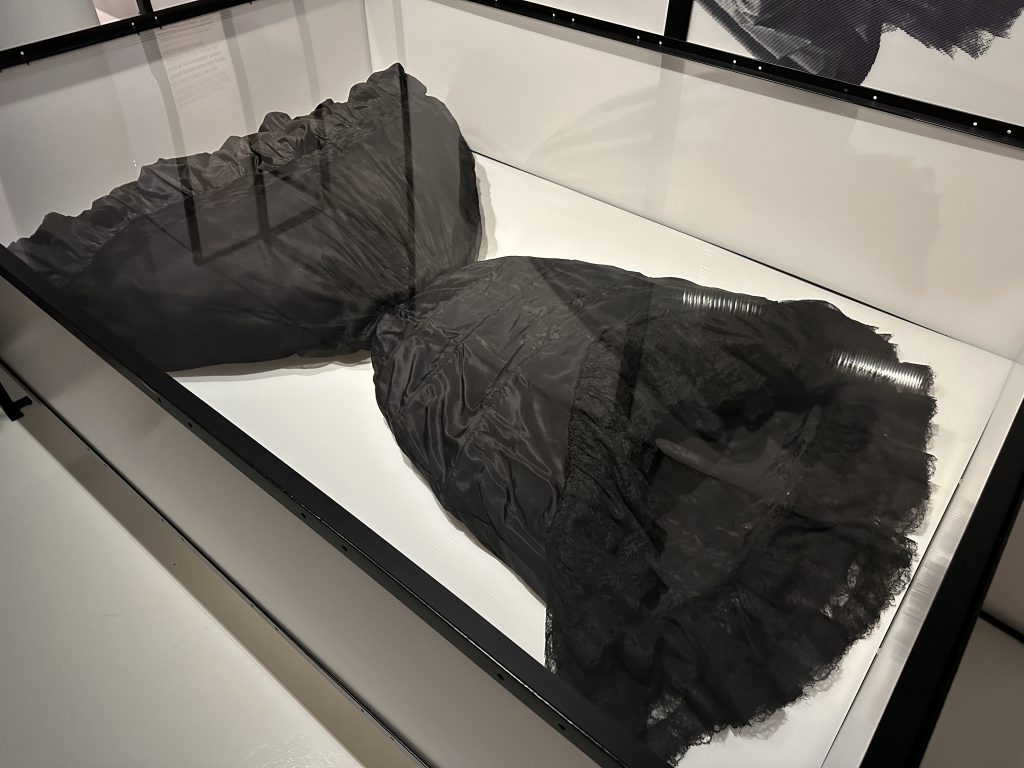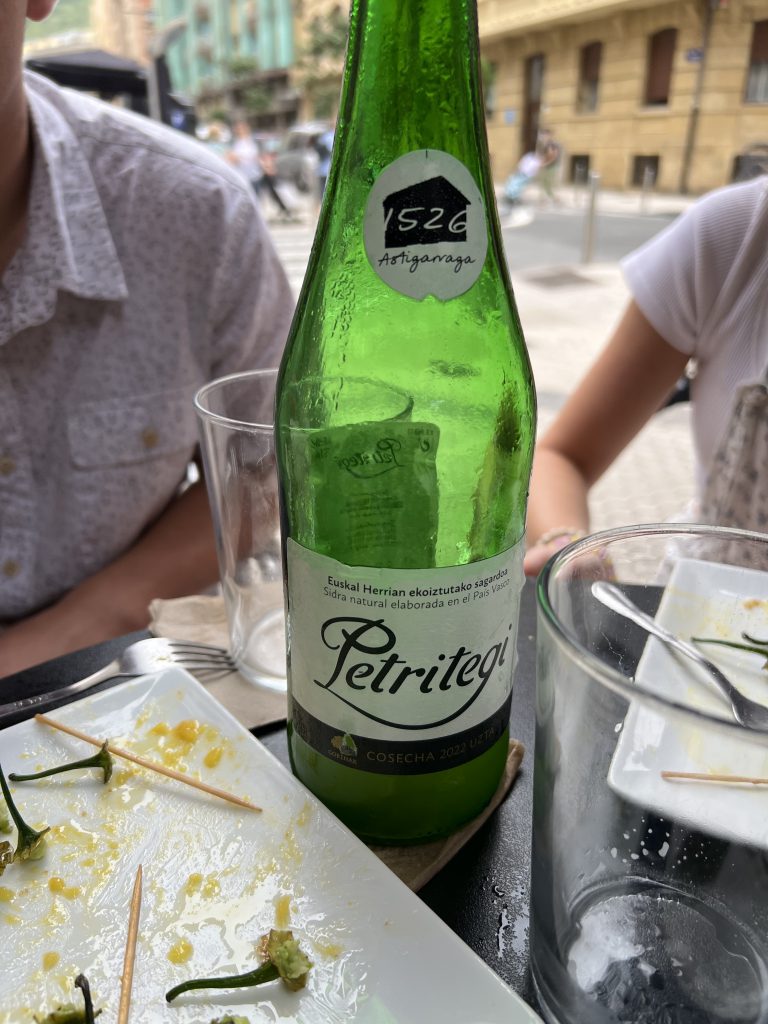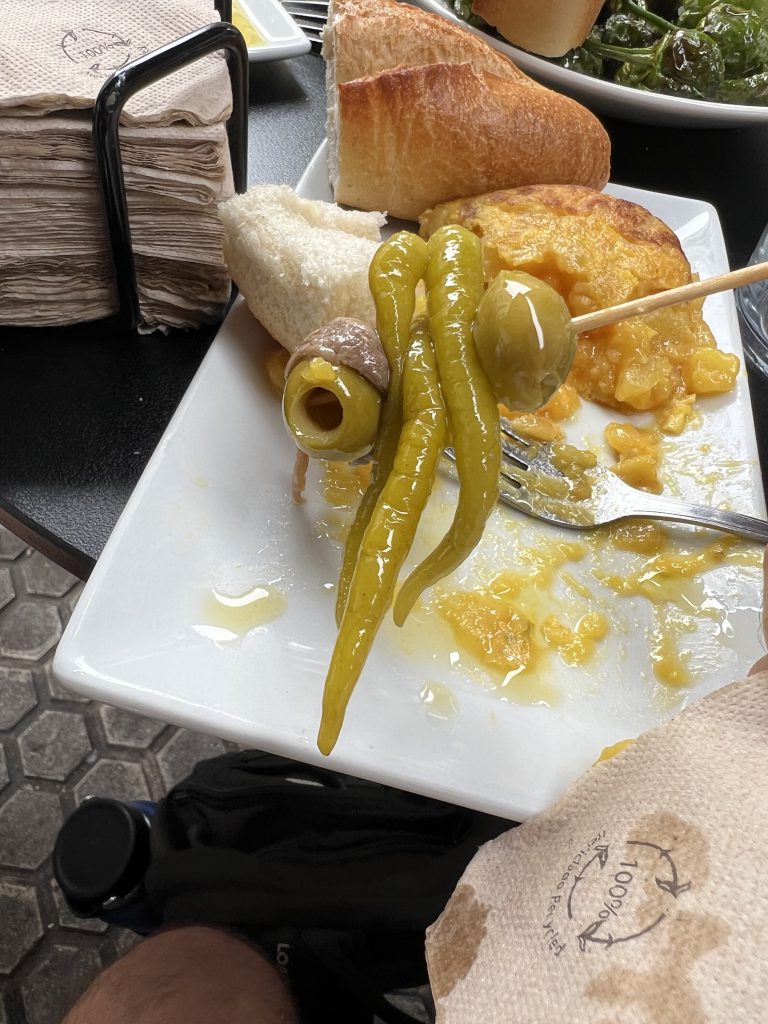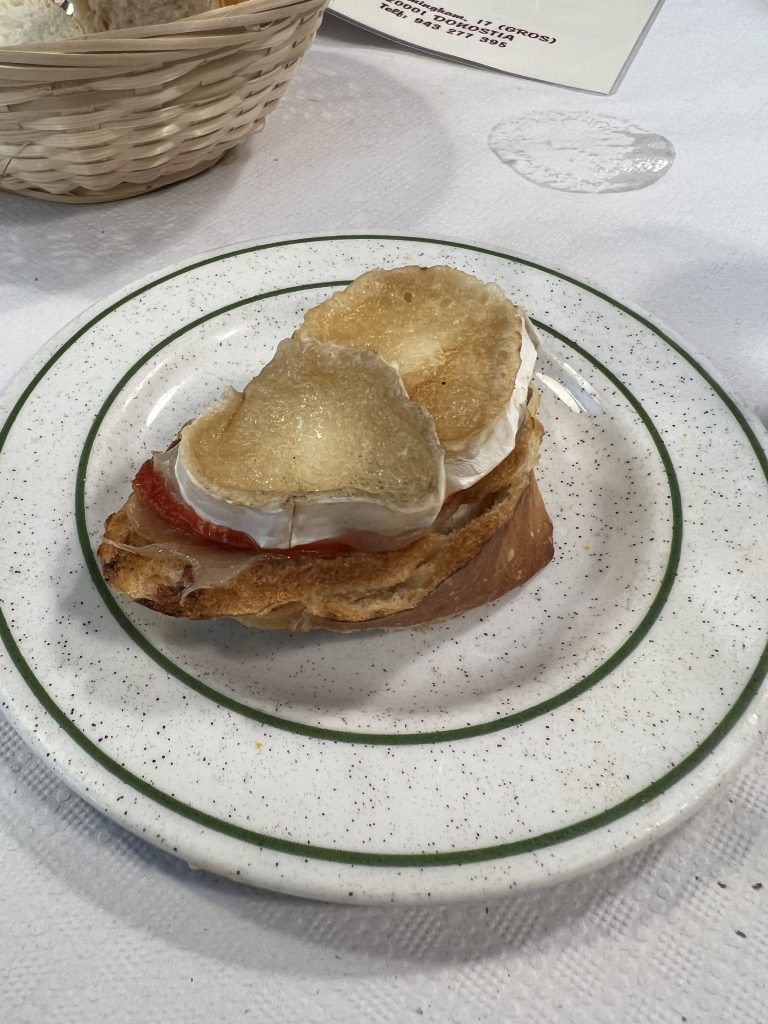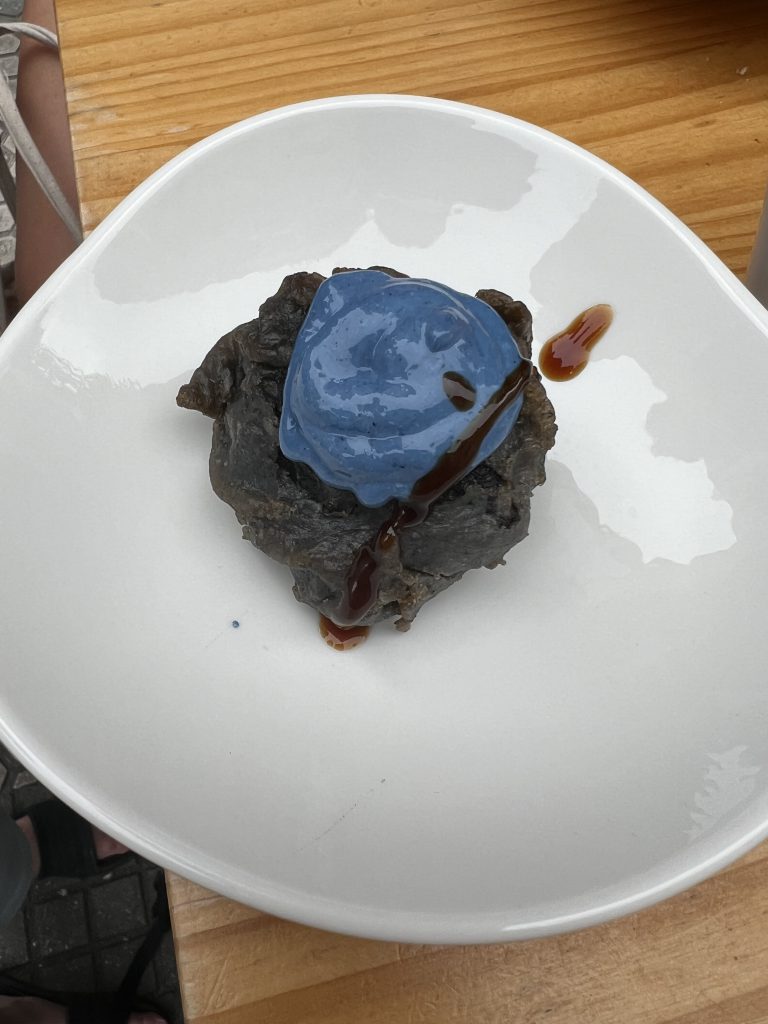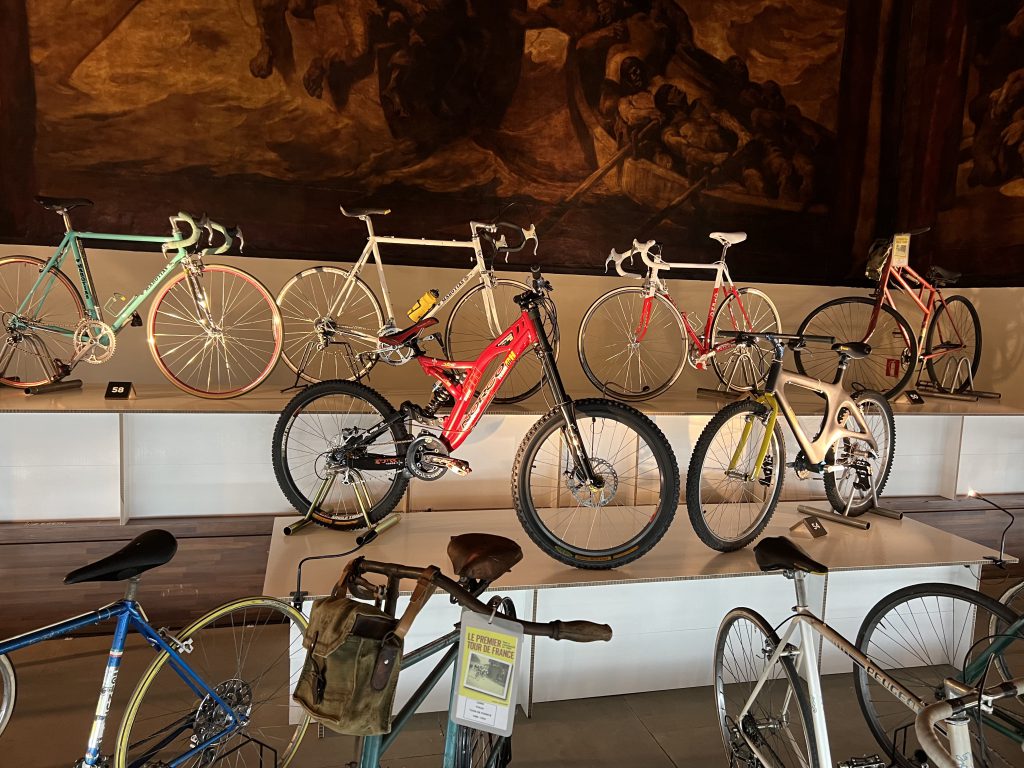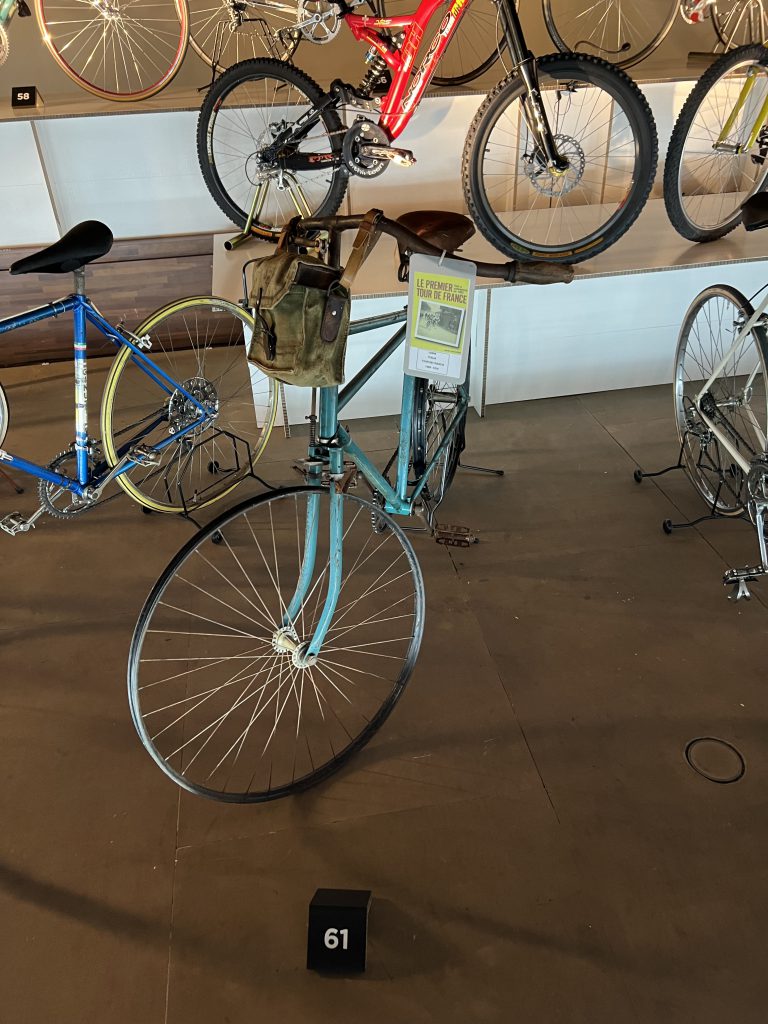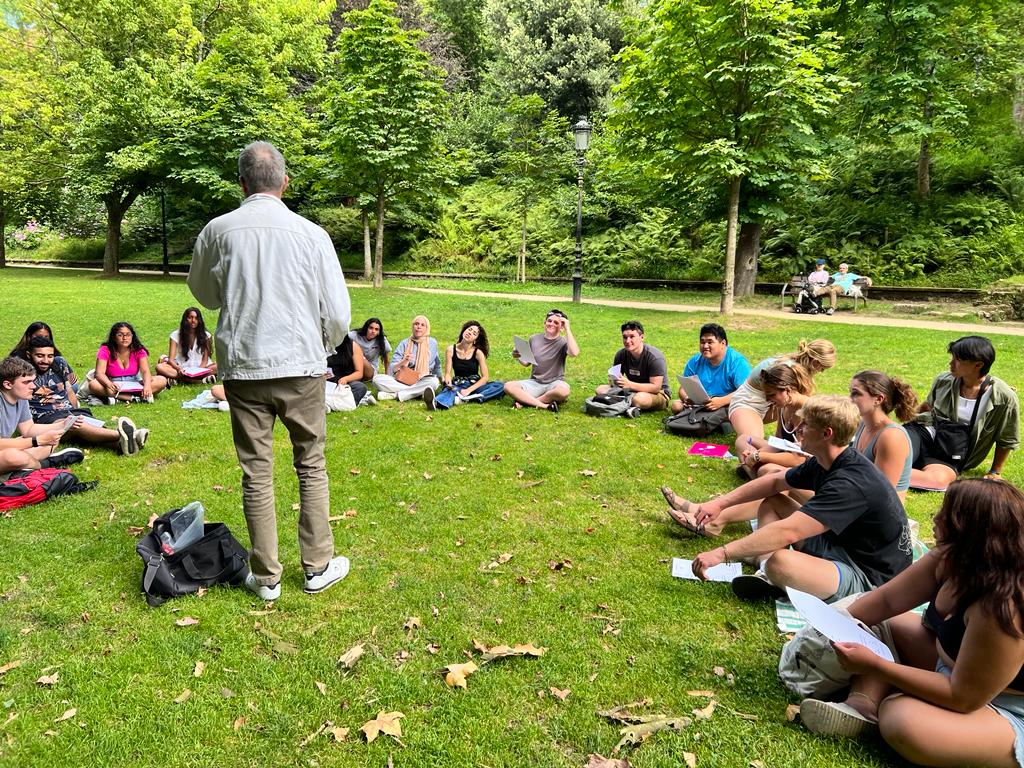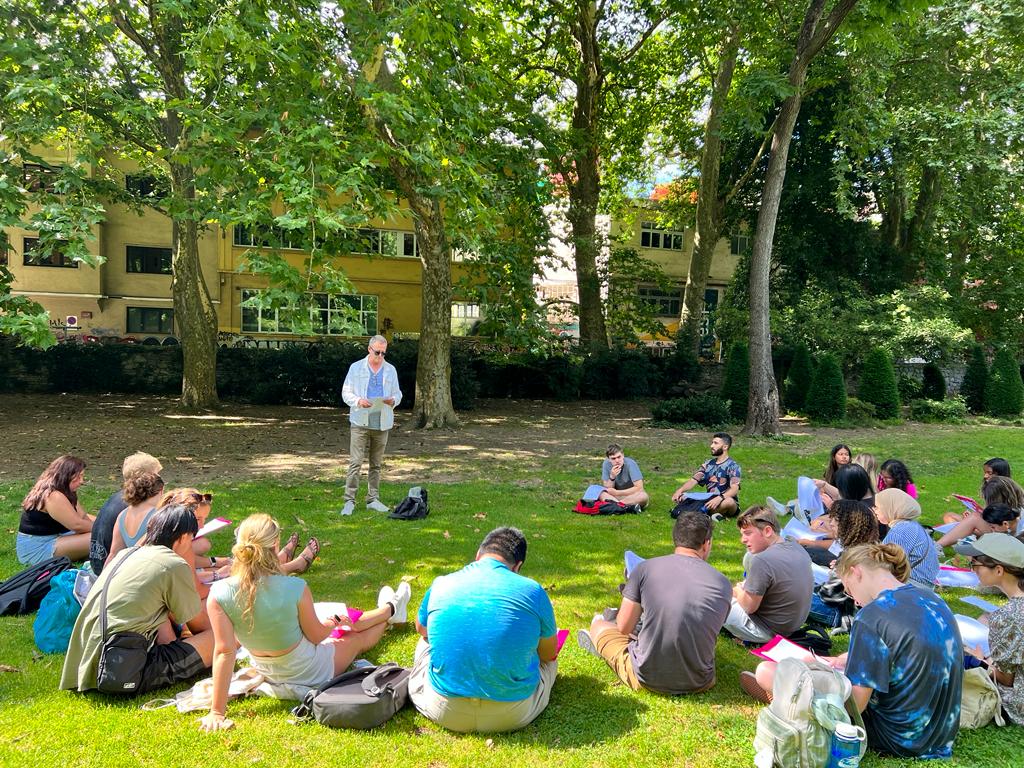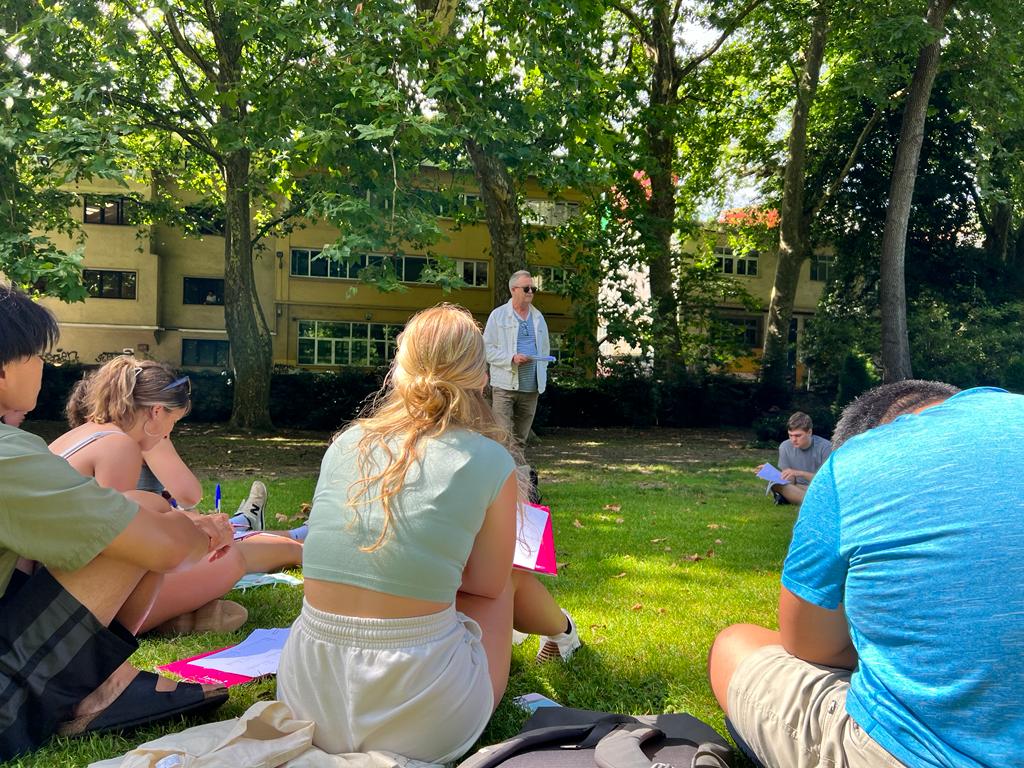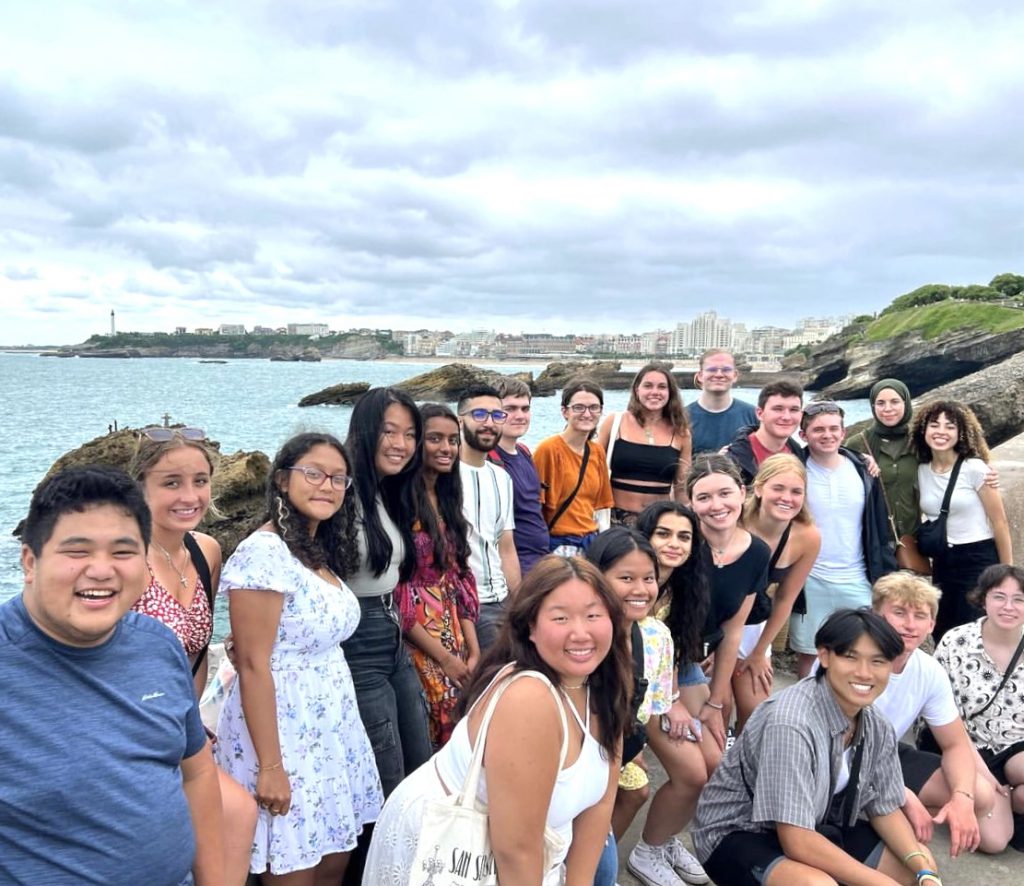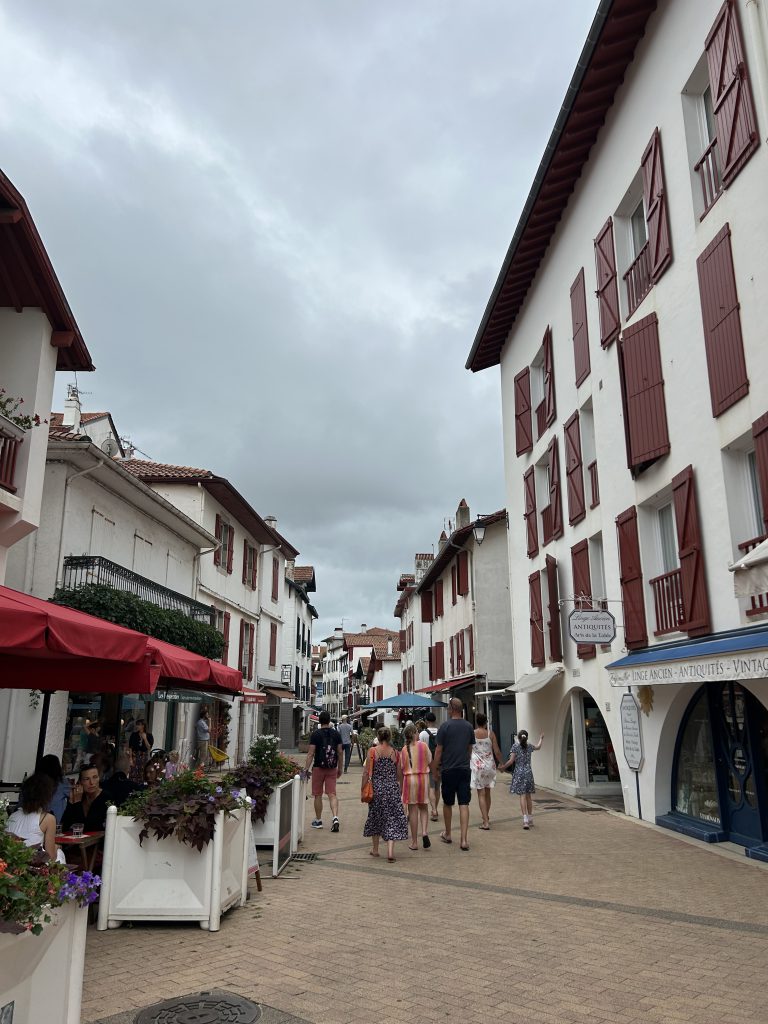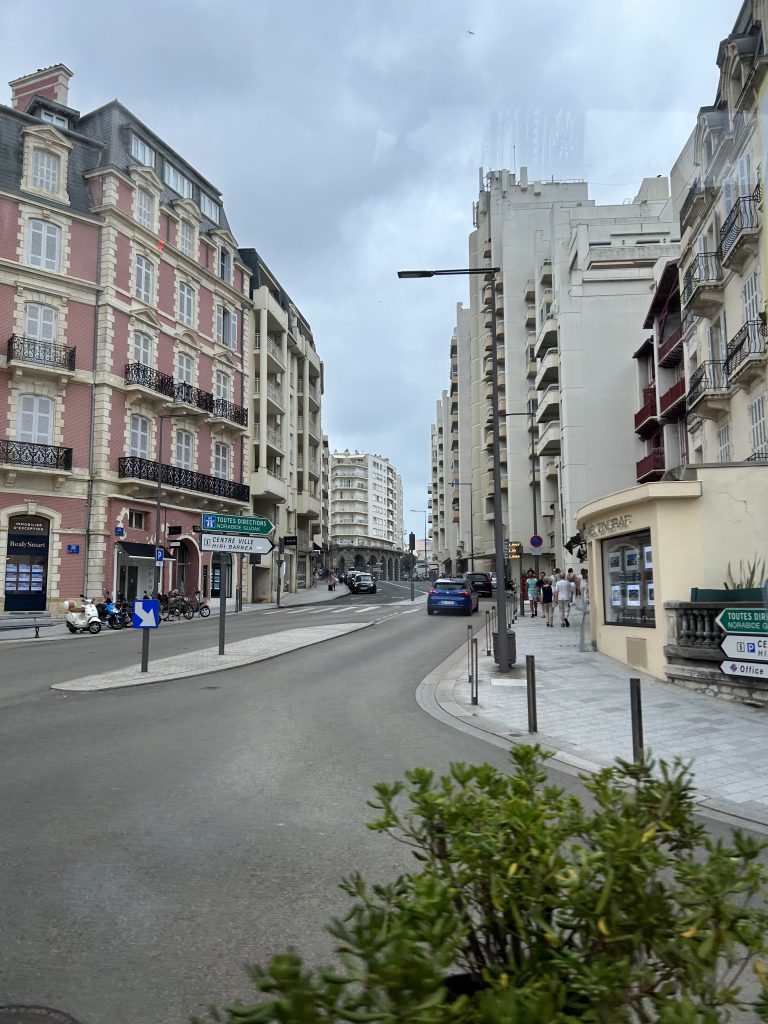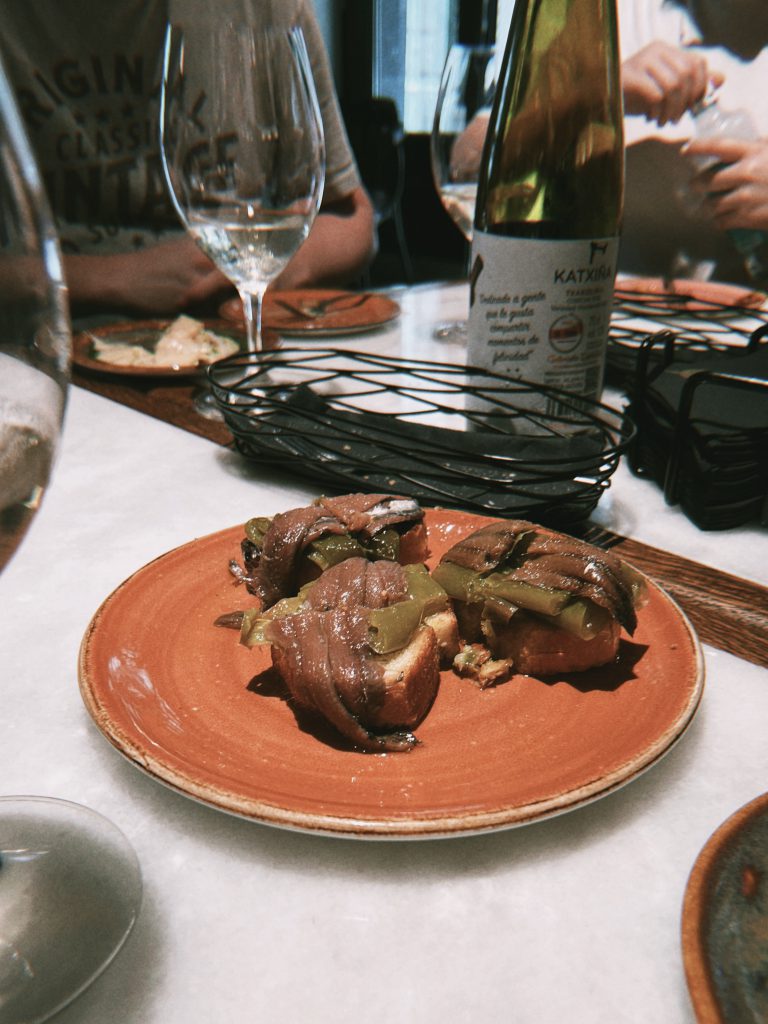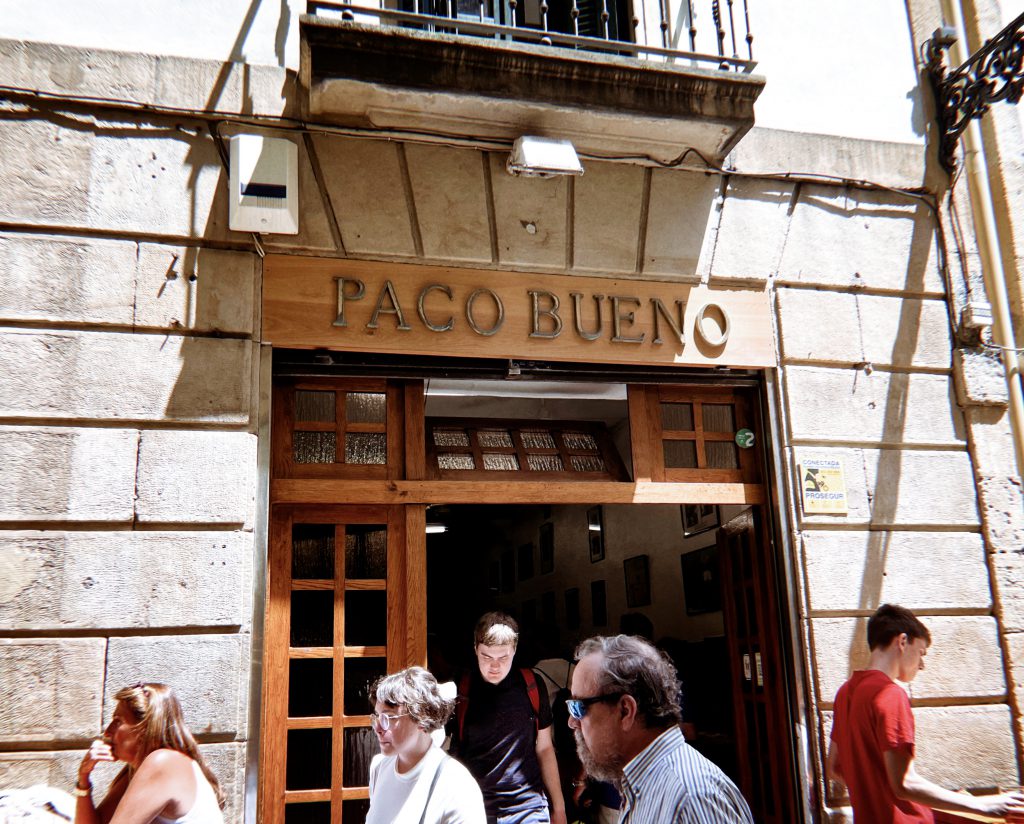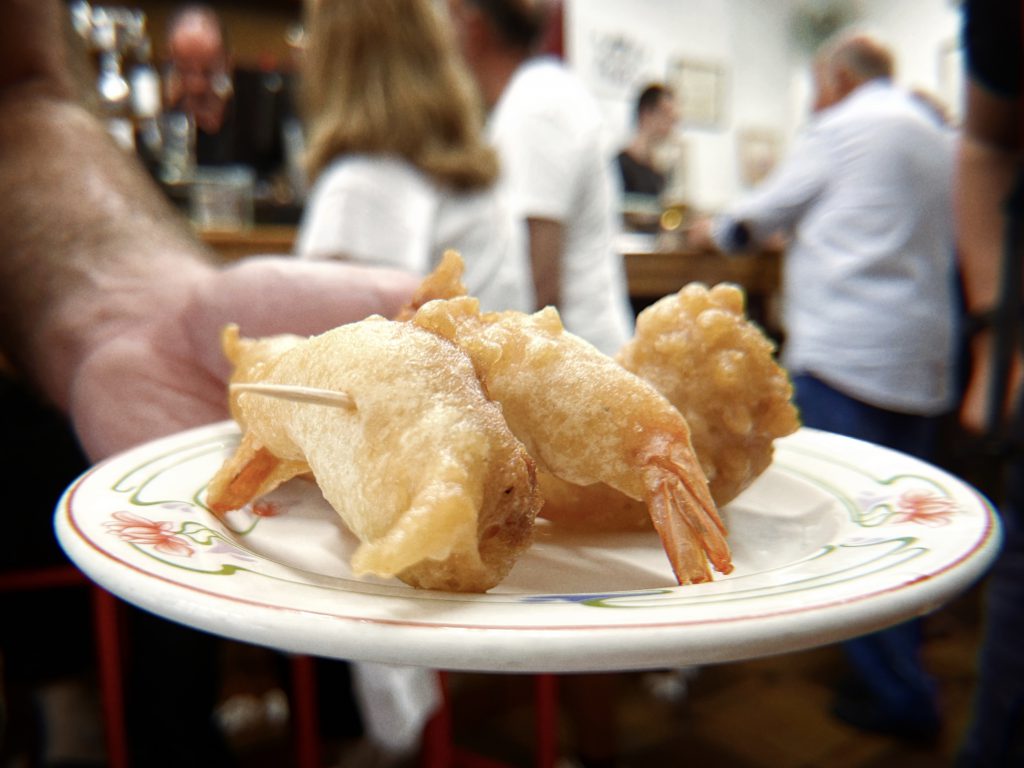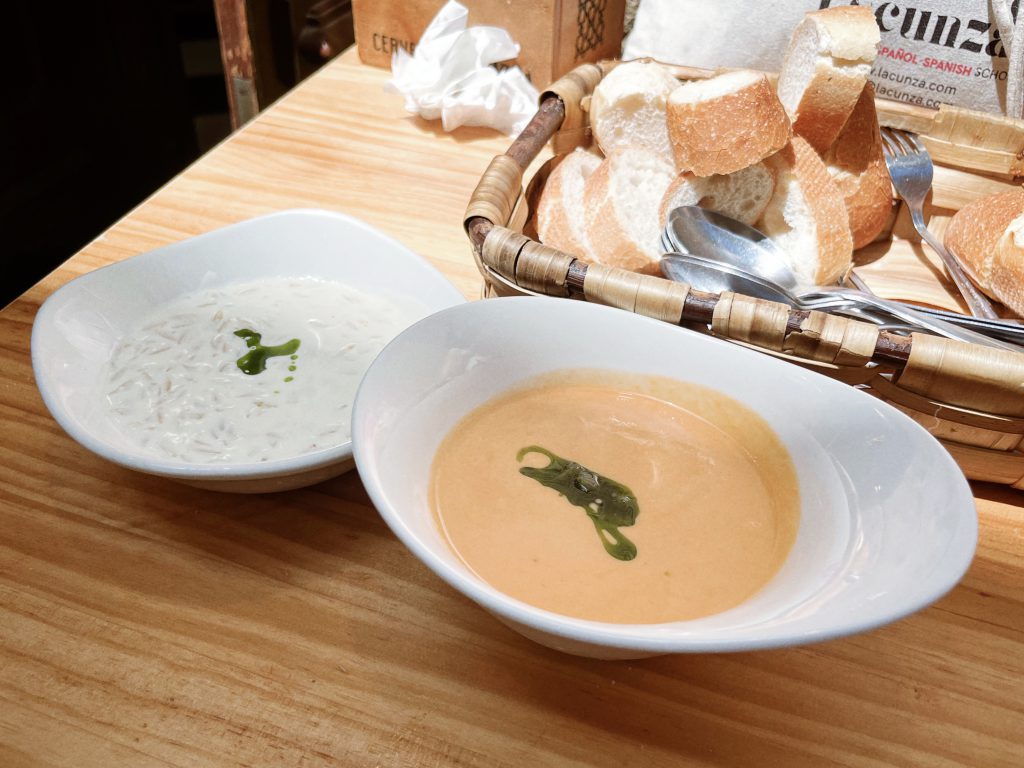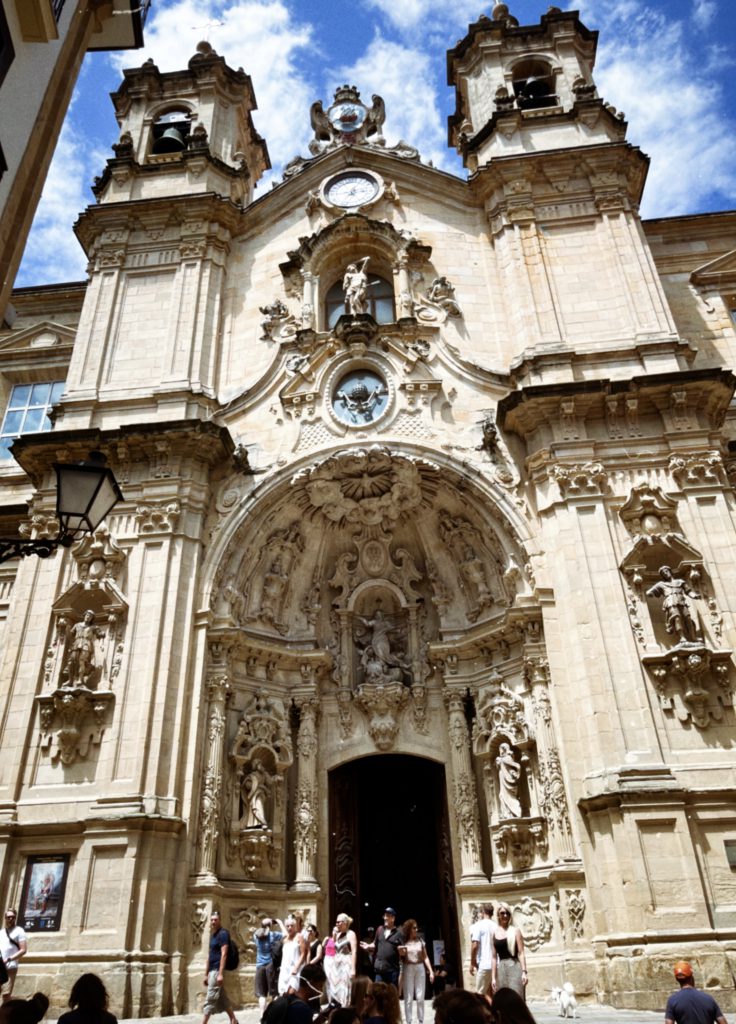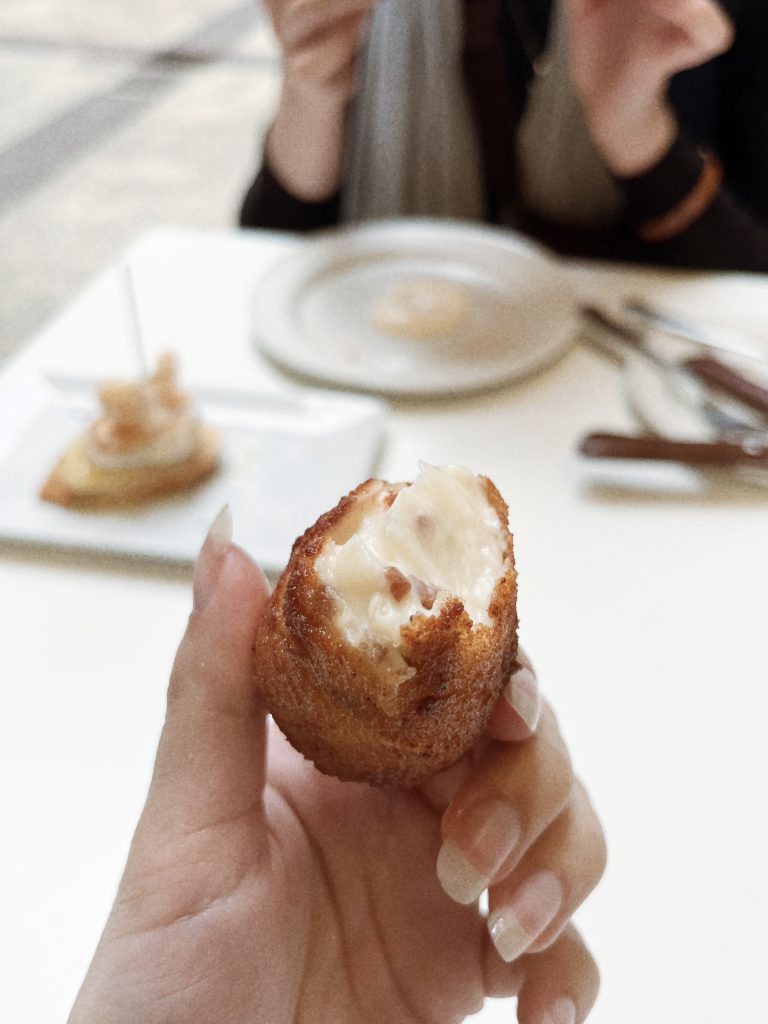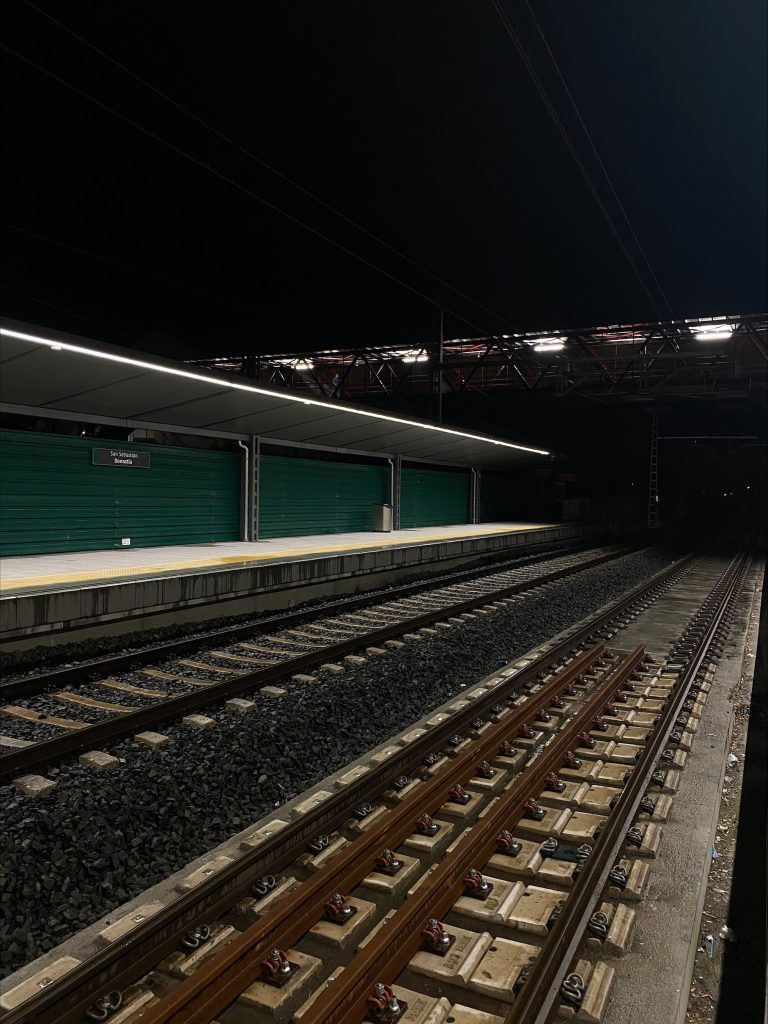
The time was around 3:45 am Friday morning and the silent rain of San Sebastian poured as we stood half awake in the lobby of Olarain Residencia, impatiently awaiting our cabs. In the distance, the hazy lights of the cabs finally drew closer and the 11 of us were on our way down the steps to settle our bags in for the short ride to the San Sebastian-Donostia Train Station. Since we had the first train of the day, the station was yet to open and our arrival was greeted by a closed door and other tired travelers. After around 30 minutes of waiting outside, security opened the doors, and we made our way to have our tickets scanned. The line stretched far to the back of the station, so we were lucky to have arrived earlier (despite losing some sleep). Upon everyone having their tickets scanned we rode the see-through elevator to the first floor where the empty tracks lay. We all stood at the yellow caution line curiously looking to the right, then to the left, trying to guess which direction the train would arrive from. Shortly, the ground began to rumble, and strong lights lit up the dark sky. The train rushed in front of us coming to a slow and steady stop. We hurried along with the train trying to catch the carts each of us was in. The cart doors opened swiftly and everyone made their way to their seats. At this moment we were one step closer to the capital of España.
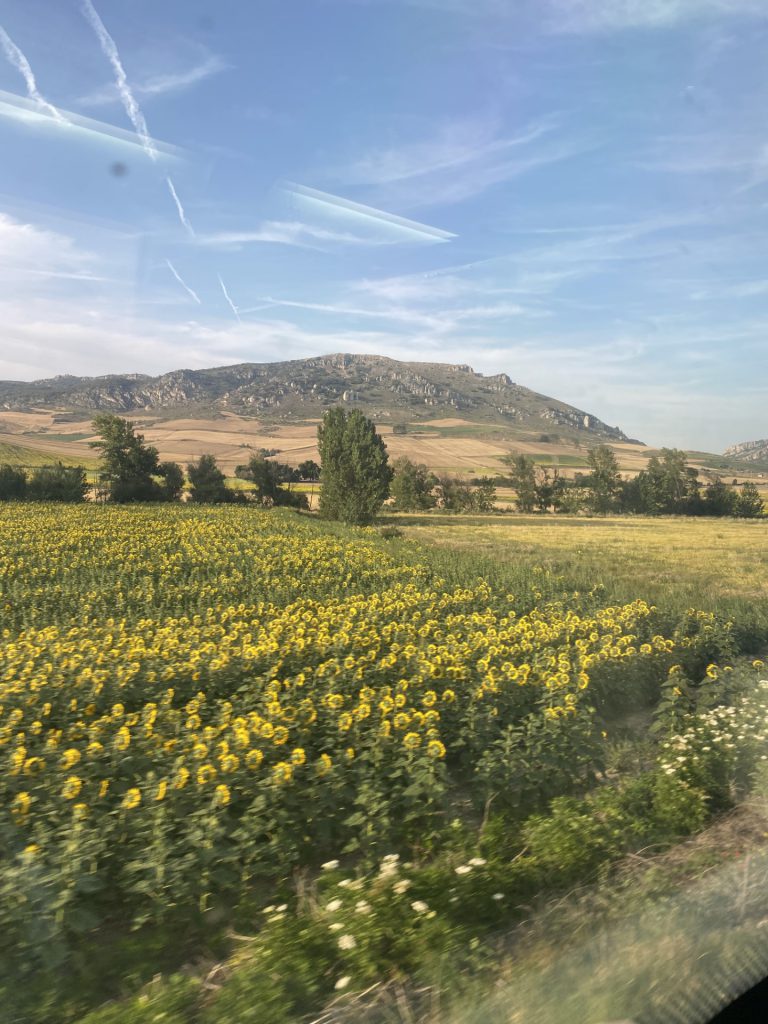
The train ride was about five hours long and having left around 5:00 am we were due to arrive at about 10:00 am. The route was very scenic as the train made its way through many diverse landscapes. During the first few hours, we rode mostly through mountainous and suburban areas. The clouds hung low and the peaks of the mountains pierced through the sky making you feel as if you were inside a painting. The more suburban areas also offered breathtaking views. Some areas had green rolling fields that looked like they went on forever, while others had a forest-like environment with trees lined up in straight rows that stretched for miles. Towards the end of our ride, the atmospheric scenery quickly transformed to more city-like with tall buildings decorated in graffiti and pedestrian-filled streets. The rapid change indicated that we were close to the capital city and soon enough the conductor came on the intercom and said that we will be approaching the Madrid station in fifteen minutes. The train began to approach the station and before it came to a stop everyone began to get up and grab their belongings from above the seats. Once the train finally came to a stop, the cart doors opened and we were finally in Madrid, España!
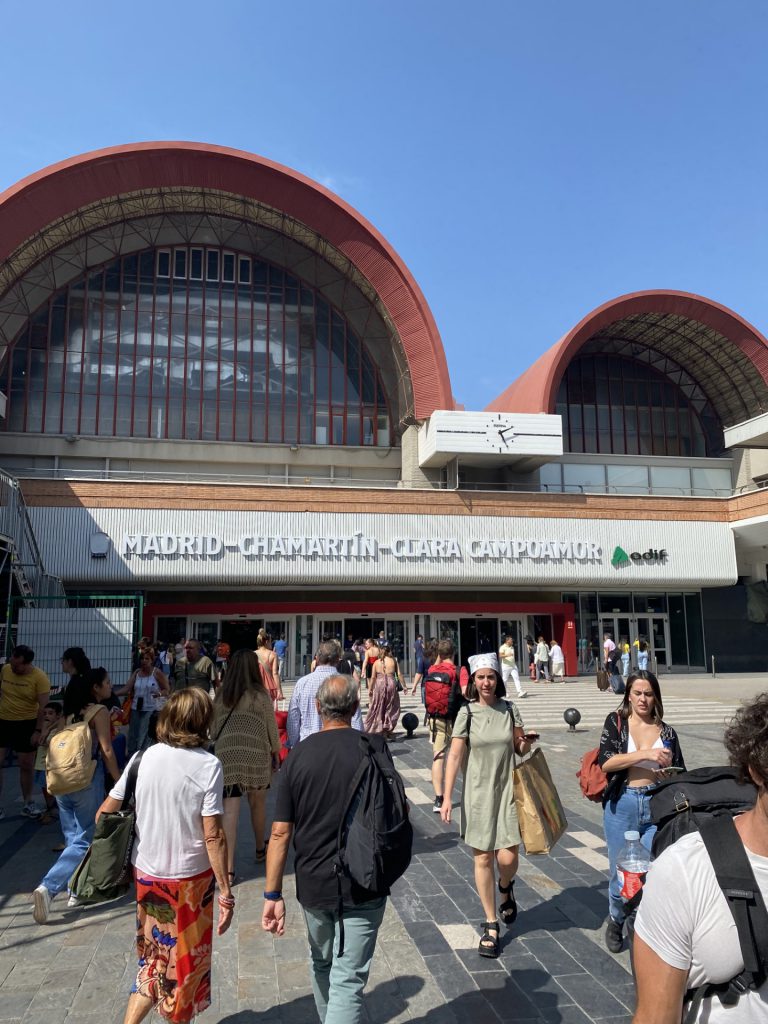
The sun in Madrid shined bright and the hot and still air instantly filled our lungs. The change in weather was noticed immediately as it was drastically different from the cool breezy weather of San Sebastian. However, despite the intensely hot weather, we continued down the tracks into the large train station of Madrid where we stopped for a quick stretch and snack. We then continued to the metro station so we could go to our hotels and drop our bags before we explored the beautiful city of Madrid. Navigating the metro in Madrid was definitely half of the experience as there were many floors with various tracks. Luckily one of our friends was an expert and easily got us where we needed to be. Without her, we probably would not have made it out of the station. We then got on the metro and some of us split up as we had different hotels. When we arrived at the hotel we dropped off our bags, settled our things, and went out for food.
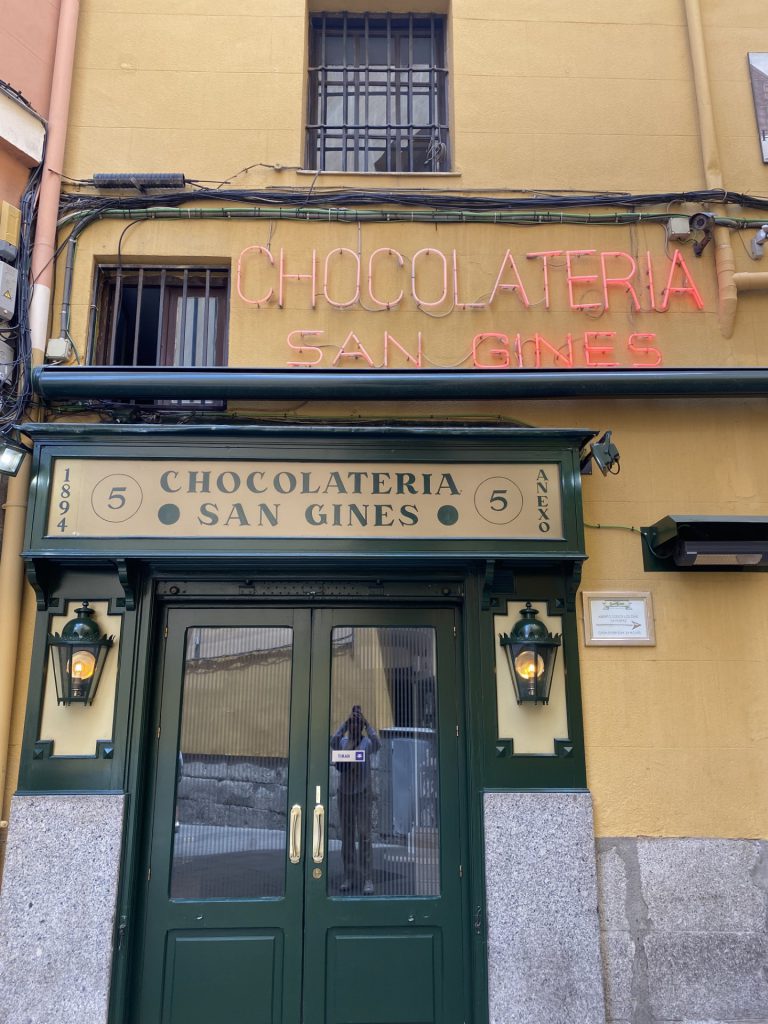
For food, we went to the Mercado de San Miguel which is a large food market that had many eclectic choices which ranged from seafood to empanadas, to fresh fruit, gelato, and even fresh meats and different quesos. It was amazing to see so many vendors with different food specialties all come together in a small space to give you a unique taste of España. Each of us got something different and it was delicious for the most part. However, In my opinion, the bacalao (cod) empanada was not my favorite but I think it’s because I was so accustomed to the fresh seafood off the coast of San Sebastian. After having our lunch, we decided it was best to get dessert which consisted of churros from the famous Chocolateria San Gines which has been running since 1894. The churros were crunchy on the outside and nice and soft on the inside. They were also surprisingly not too sweet but that did not take away from how delicious they were. If anything, it gave the churro its own uniqueness. However, the chocolate dip that came with it was our favorite part and definitely the cherry on top. The chocolate was a thick syrup-like consistency and it stuck firmly on the churros giving it more texture and immense flavor. We sat outside the Chocolateria for a while enjoying the churros and planning our schedule for the next day. We then asked for la cuenta and headed to the main street in Madrid to do some light shopping at the department stores. The stores were very large and had many more options than we would normally see back home which was ideal. Each store had at least 3 floors and the fashion ranged in style. Some of us bought some stuff but at this point, we were extremely tired from lack of sleep and walking around so we decided to head back to the hotel to take a short nap before dinner.

We headed out again around 6 pm to continue exploring the city and went on the lookout for dinner as well. The place that came to mind was Plaza Mayor. The walk to the Plaza was scenic as we made our way through the small allies of Madrid consisting of cobblestone grounds and local shops and restaurants that were in m neutral-colored buildings that stretched tall. We took our time getting to the Plaza and tried to take in as much of the city as we could. Upon arrival, a large arc in the corner welcomed us into Plaza Mayor. The plaza itself was a large area encased in a large red building with arcs on all four sides which took you into different parts of the city. The Plaza also had a large statue of equestrian Phillip III that caught everyone’s attention as it stood alone in the center of the plaza. Around the plaza were many restaurants that had a very interesting way of getting customers. Coming from San Sebastian, we were accustomed to approaching a restaurant and reading its menu on the walk then deciding whether to eat there or not. The waiters did not did not approach customers unless they made the decision to eat there. However, in Madrid, it was very different. The waiters at the restaurants would approach you while walking and ask you to come to eat and some even began to explain their menu. It was not necessarily a bad thing but it was intriguing to notice the different etiquette within the same country. Although the restaurants in Plaza Mayor looked appetizing, it was recommended that we eat from restaurants that were just outside the Plaza as they had better prices and arguably better food. In our experience, we enjoyed the small restaurants outside the Plaza Mayor. The food was great and it was notable that the chefs put much effort into each dish they made. After dinner, all of us met up for a late walk around the city before we called it a night and headed back to the hotel to prepare for the next day.
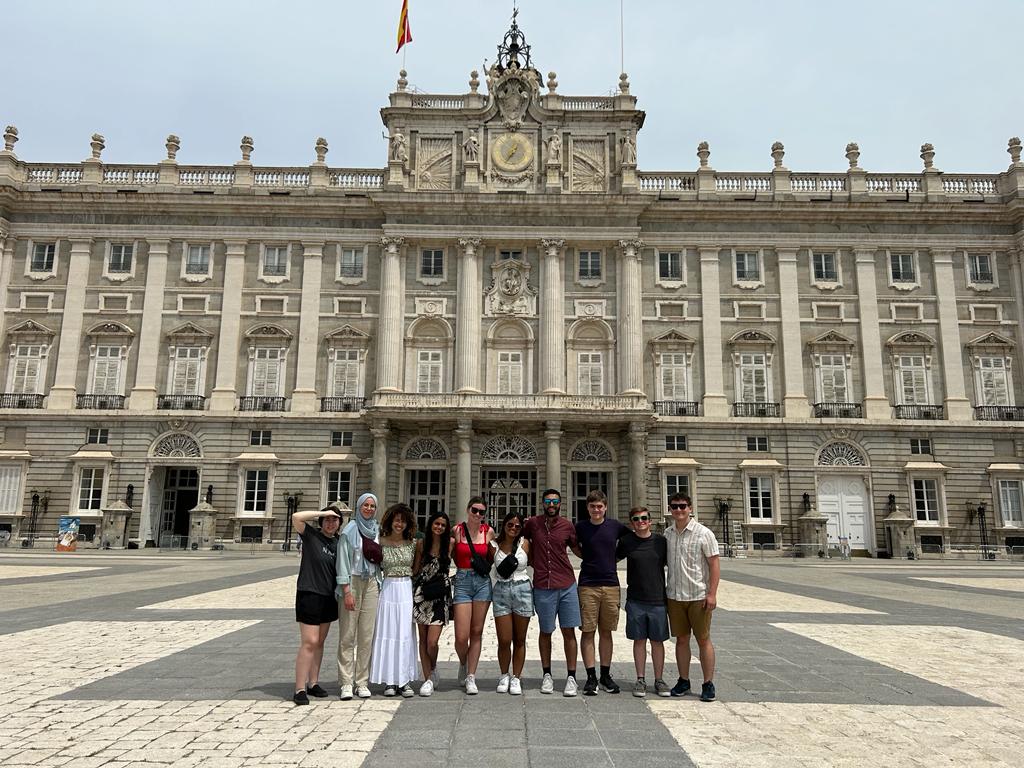
The next morning we had a fairly early start as we had a reservation to go see the royal palace. We had a quick breakfast and walked down to the royal palace. Just outside the palace was a gorgeous garden with a large fountain, bushes cut to perfection, and statues of previous kings that ran along both sides of the garden. The garden was very beautiful but our focus was on the palace. So after a few pictures, we made our way to the outside gates of the palace to enter. Upon entrance, we quickly noticed the arcs on the right side of the palace which looked down upon the city. The view was absolutely breathtaking and looking out gave a full view of Madrid along with what looked like mountains in the distance. The view was hard to leave, but eventually, we made our way into the actual palace. The entrance was grand with extremely large ceilings and windows that decorated the front walls. Walking more into the palace and up the main stairs was a large statue of what seemed like a previous king on a large throne. Then looking up at the ceiling was a grand painting that consisted of a light blue sky, civilians, and angels. While admiring the painting, we also wondered how the painting was made with such precision on an extremely high ceiling. We then continued up the stairs where the self-guided tour really started. Unfortunately, it was forbidden to take pictures or video of the upcoming rooms but it was for the better as it allowed us to really take in the moment and appreciate the history and art in such an important place. My favorite part of the royal palace is how every room had its own style. Each consisted of its own ceiling painting, painting of previous monarchs, and artifacts like large grandfather clocks, mirrors, and various tapestries. Even the wallpaper that decorated the walls remained unique to every room. Although every room was directly connected to the next, none seemed to remind you of the last. The designs were impeccable and the stories behind each item in the room were interesting. Some decorations were made per request while others were gifted by other countries to express close relations. Continuing through the tour some of the rooms we were able to visit were various bedrooms, the Crown Room, the Royal Chapel, The Stradivarius Hall, and The room of King Charles III and the Queen. Having visited so many rooms in the palace it was nowhere near the actual size of the palace since the palace actually consists of 3,418 rooms. After finishing our incredible tour of the museum we went to the gift shop to get some souvenirs then went out for lunch which we had at a local place near the palace.
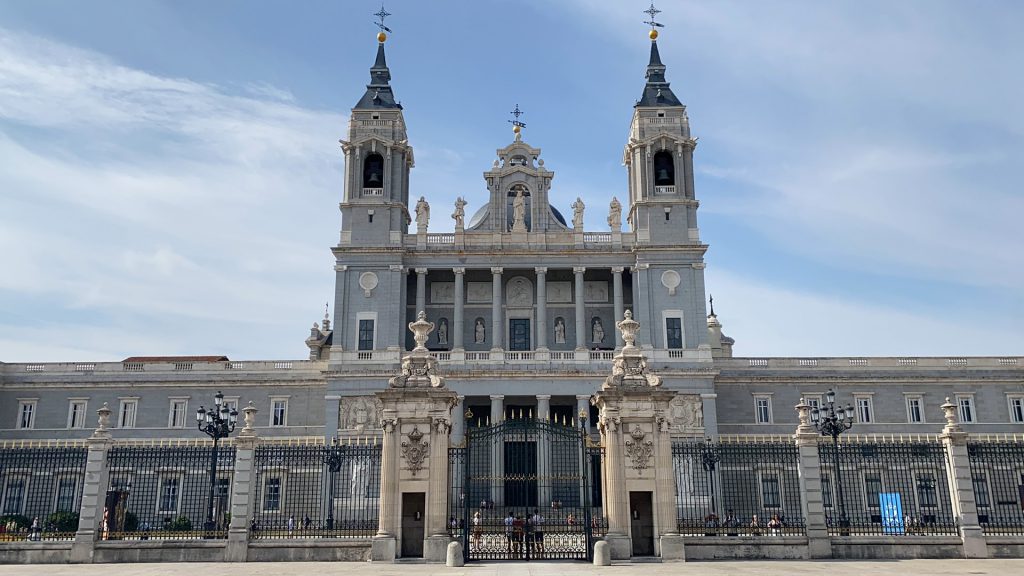
After lunch, we had one more thing on our bucket list for the day.We decided to visit the Almudena Cathedral. Inside the Cathedral was beautiful and it gave a very rustic style. All the windows were paned with mosaics and the architecture was truly magnificent as you could see the arcs on every walkway and exposed beams that gave it a more open feel. It also contained mini stations along the sides of the cathedral. Each station lit up with artificial candles but also had a mini-story along with a display. The cathedral also had multiple spaces for people to pray and even a separate quiet room. Overall it was a great experience to have extremely eye-catching architecture and the art inside. Upon finishing up at the Cathedral most of us split into smaller groups and continued our day with more souvenir shopping and sightseeing. After dinner, we met back up at the hotel and went to bed dreading that the next day was our last in Madrid.
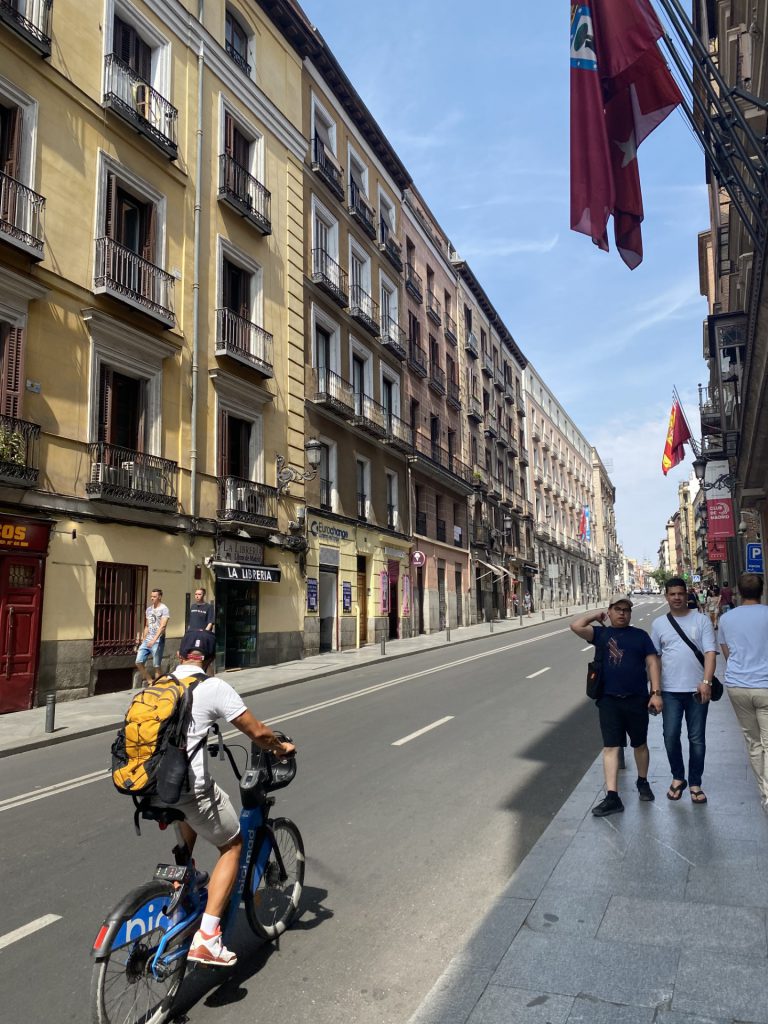
Sunday was a short day as we had to pack our bags and head out for the train station around 4:00 pm. We tried to make the most out of our day by going to brunch together and also walking around Madrid trying to soak in all its glory before leaving it behind. To me, architecture always stood out and I enjoyed everywhere we went, the allies always provided a scenery that is almost hard to describe with words. Our last stop in Madrid was a small bakery near the royal palace that was well known for its meringue. Upon finishing up, it, unfortunately, was time to head to the train station and say goodbye to the capital of Espana. Our short time there was filled with wonderful experiences that are truly unforgettable. We were so lucky to be able to travel to such a diverse city that is rich in history and art. Whether it was the Gran Via, Grand Boulevard, Plaza Mayor or the side streets and little alleys, every walk was filled with unforgettable scenery . Although leaving Madrid was sad, I think a lot of us agreed that we were a little homesick from San Sebastian. Speaking for myself I can say I missed the normality that I felt. But despite that, I heavily enjoyed Madrid and hopefully will be coming back sometime in the near future for a longer stay so I explore the parts that I have yet to discover. Hasta Luego Madrid!

